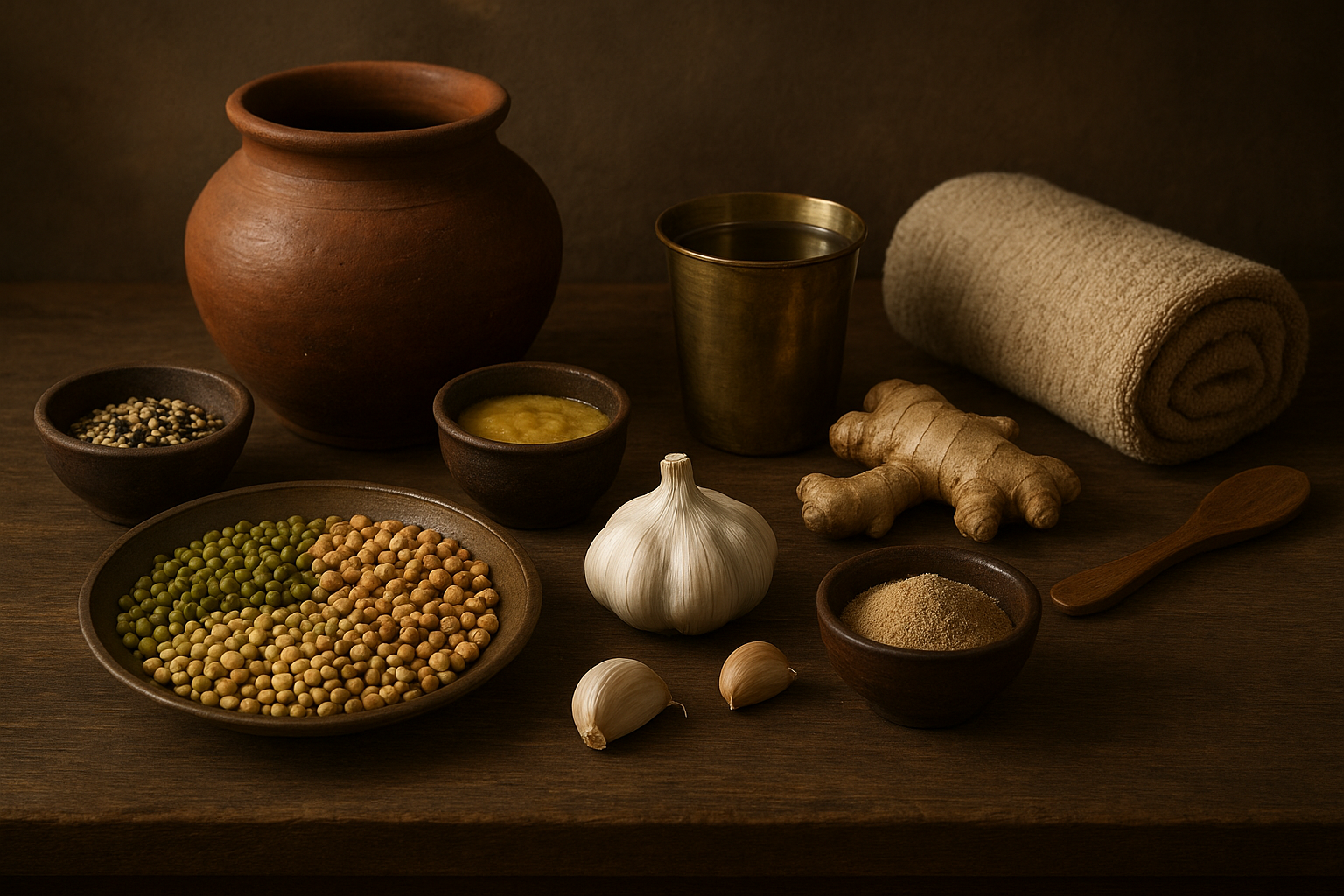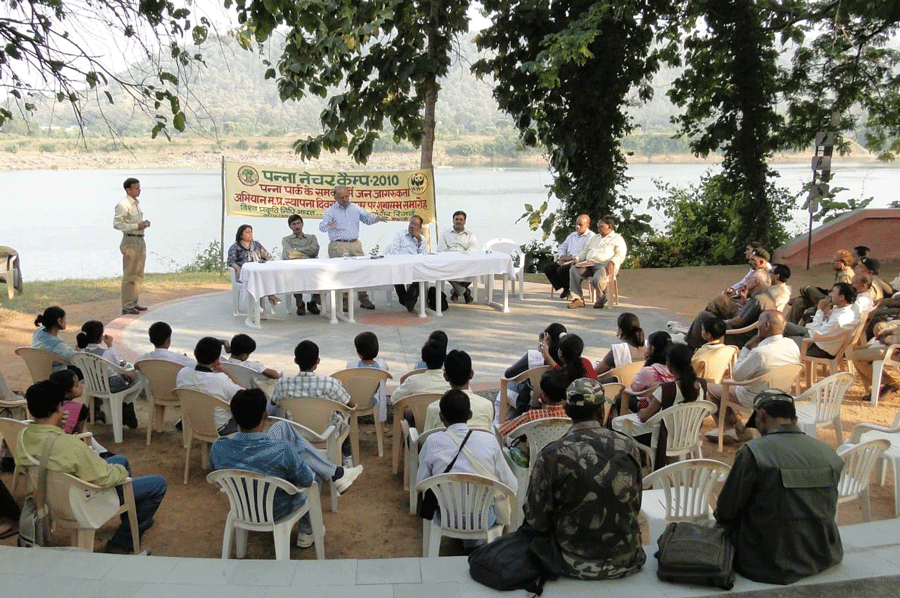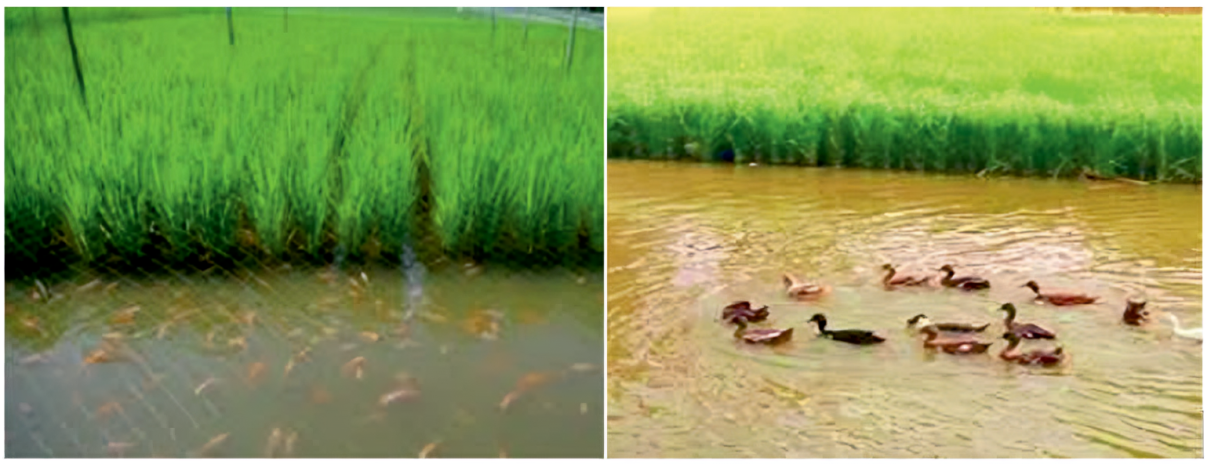Role of Integrated Farming in Livelihood Generation
INTRODUCTION:
The farming system is the scientific integration of different interdependencies and interactions of farm enterprises for the efficient use of land, labour and other resources of a farm family which provides year-round income to the farmers. Integrated farming system (IFS) is an interdependent, interrelated often interlocking production systems based on few crops, animals and related subsidiary enterprises in such a way that maximize the utilization of nutrients of each system and minimize the negative effect of these enterprises on environment. IFS represent multiple crops (cereals, legumes, oilseeds, tree crops, vegetables etc.) and multiple enterprises (livestock, bee-keeping, fish farming etc.) in a single farm in an integrated manner. For the small-and marginal-farmers of India, who constitute more than 85% of the total farming community, IFS plays a vital role for enhancing their economy and livelihood. The main objective of the IFS is to enhance the productivity and profitability of marginal farmers households and to improve the livelihood and nutritional security through diversification approach. Under the gradual shrinking of land-holding, it is necessary to integrate land-based enterprises like dairy, fishery, poultry, duckery, apiary, field and horticultural crops, mushroom, agroforestry etc. within the bio-physical and socio-economic environment of the farmers to make farming more profitable and dependable. The ultimate goal is to maximize production, productivity and income generation from a unit of land area over a stipulated period (Dashet al., 2015). Furthermore, IFScontributes to nutrient recycling, reduces dependency on external inputs, enhances soil quality indicators, and ensures environmental safety. Hence, adaption of a developed location-specific IFSmodel plays a vital role in biodiversity conservation, improves soil carbon, and contributes to reduction of greenhouse gas emissions (GHGs) (Meenaet al., 2023). Our country’s population is anticipated to reach 1370 million by 2030 and 1600 million by 2050. Developed IFSsgave higher net returns and benefit: cost ratio to the tribal farmers as compared to traditional farming in hilly region.
An IFS is a holistic and system approach, in which natural mechanism of the system is explored by establishing compatible linkages among the various components, which make it sustainable. Such a system approach is very much needed for developing sustainable model for E-IFS (Energy self-sufficient IFS), organic farming, natural farming, Natural eco farming and conservation faring systems.
An IFS represents multiple crops (cereals, legumes, oilseeds, tree crops, vegetables etc.) and multiple enterprises (livestock, bee-keeping, fish farming etc.) in a single farm in an integrated manner. The level of integration can be easily measured with the level of resources, wastes and by-products recycled within the system. This helps in better utilization of various resources available within a system and enhances the resource use efficiency. More the recycling of the resources/by-products/wastes, the better is the integration. Such resource flow within the farming system makes the system self-reliant, less dependent on external inputs and sustainable. In the IFS model developed for small-and marginal farmers with 1.0 ha area involving the enterprises crop-livestock (dairy, poultry and duckery)- biogas production-fishery-agroforestry composting-medicinal and nutritional garden efforts have been made to recycle the by-product and wastes of one enterprise as the in-put of other enterprise. This has helped in enhancing the resource use efficiency and reducing the production cost. Besides, the farming systems become more self-reliant and less dependent on external inputs.
Components of IFS Models:
Crops, livestock, birds and trees are the major components of any IFS. Crop may have subsystem like monocrop, mixed/intercrop, multi-tier crops of cereals, legumes (pulses), oilseeds, forage etc. Livestock components may be cow, goat, sheep, poultryand bees. The farming system takes into account the components of soil, water, crops, livestock, labour, capital, energy and other resources, with the farm family at the centre managing agriculture and related activities. The followings are integrated components of IFS (Behera et al., 2018).
Fish + poultry+ horticulture-based farming system:
This IFS model was developed using fish, poultry and horticulture components that play a significant role in increasing manifold production, nutrition, profits, and employment generation to marginal farmers of Udham Singh Nagar district of Uttarakhand as reported by (Sharmaet al., 2016). Another study conducted reveals that the integration of fish culture with a rice-wheat cropping system can attain the maximum profit in western Uttar Pradesh.
Similarly, a fish-based IFS model was developed on 0.9 ha of land (fish cum horticulture on pond dyke (0.5 ha) + rice-wheat (0.4 ha), where fish as a major component was promoted to maximize the farm income and efficiently utilized farm resources. For this purpose, a farm was selected based on its strategic location, water availability, low land condition, etc. (Sunil et al., 2023). Besides, fish culture pond dykes were chosen for the development of horticulture module (vegetable cultivation). Existing management practices (low input-based aquaculture) like fishes fed with rice polish and intermittent spread of mustard oil cake in pond (Bahera et al., 2004). The existing productivity of fish ponds was less than 20 q/ha. As a result of adoption of improved management practices, the fish pond production rose up to 35 q/ha (75.0%).Scientists of Krishi Vigyan Kendra have helped farmers in Rajasthan’s Barmer district grow fruits and vegetables never grown here before, and earn up to five times more. Lush fields of vegetables or orchards of fruit can hardly be associated with Rajasthan’s Barmer district, which lies in the Thar desert on the border with Pakistan (Mishra, 2022)
Crop + livestock-based farming system:
Climate change, nutritional security, land shrinkage and increasing human population are the most concerning factors in agriculture and a further complicated by deteriorating soil health. Among several ways to address these issues, the most important and cost-effective means are to be adopted in IFS. IFSs with livestock enable a way to increase economic yield per unit area per unit of time for farmers under small and marginal categories (Shanmugam et al., 2024). This system effectively utilized the waste materials by recycling them via linking appropriate components, thereby minimizing pollution caused to the environment. Further, the integration of livestock component with crops, the production of eggs, meat and milk leads to nutritional security and stable farmer’s income generation. So, there is a need to develop an eco-friendly, ecologically safe and economically profitable IFS model in western Uttar Pradesh (Palsaniya et al., 2021).
IFS under coastal agro-ecosystem:
The long-term projections prove that by 2030, about 40% of the dietary demand has to be met from livestock-based commodities other than food grains (Kumar et al., 2018). At present, improvement in the productivity of crops is being examined from their sustainability viewpoint not only by agricultural scientists, planners and environmentalists but also by progressive farmers, who are switching over from modern insensitive farming to ecologically protective farming (Ponnusamy and Gupta, 2009). The coastal ecosystem faces a lot of problems like flash floods, water logging, seawater intrusion, salinity and pollution due to continued expansion of urbanization, industrialization, tourism and other activities. About 10.78 million hectares of land resources of coastal ecosystems support the livelihood security of several million rural poor and also contribute to the national economy in a larger measure (Swarnam et al., 2024). Considering land capability in the coastal ecosystem, the increase in land productivity primarily depends on popularization of alternative land use systems like dairy, fishery, apiary, duckery, mushroom, tree plantation, etc. Therefore, the research focus needs to be reoriented toward developing IFS options, well matched with land and water regimes in coastal areas for sustainable increase in productivity and conserved coastal ecosystem (Sunil et al., 2023).
Agro tourism farming:
Agro tourism is a way of developing the rural location as part of developing these tourism areas sustainably with a concern to increase the living standard of the farm and rural people by providing them the additional avenues of income. Agro tourism has emerged as an unconventional way of increasing farmer’s income. Hence, the farmers should adopt agro tourism to diversify agricultural goods and explore new markets to generate more money through agro tourism, rural tourism provides an option for visitors to experience uncover rural life, their farm and other related activities and social and cultural practices which ultimately help the people sustainably living in that locality. The agro tourism development based on local wisdom concerns tourism development and subsequent conditions of sustainable development, as stated by Sriyadil and Eni Istiyanti (2021).
Medicinal garden:

There areseveral types of gardens such as medicinal, garden which may double farmers income. India has been considered as a major store house of various indigenous plants that are used to cure disease and disorder of various kind. Small-and marginal farmers of India usually prefer such plants, since these are safe, economical and easily available to them. A small medicinal garden in 100to150 m² area is maintained in IFS unit consisting of medicinal plants such as: sarpagandha (Rauvolfia serpentina), ashwagandha (Withania Somnifera), aloevera (Aloe barbadensis), tulsi (Ocimum tenuiflorum), lemon grass/citronella grass (Cymbopogon citratus), ajwain (Trachyspermum amni), brahmani (Bacopa monnieri), mint (Mentha piperita), hadajod (Cissus quadrangularis), insulin plant (Costus igneus), soursop fruit plant (Annona muricata), harida (Terminalia chebula), kalmegh/Green chiretta (Andrographis paniculata), harsingar (Nyctanthes arbor-tristis), Giloy (Tinospora cordifolia), sadabahar (Catharanthus roseus). pathharchata (Kalanchoe kinnata), small cardamom (Elettaria cardamomum), curry leaf (Murraya koenigii) and shatavari plant (Asparagus racemosus).
Nutritional garden:
A small nutritional garden in 150 to 200 m² area was maintained in the IFS unit consisting of papaya (Carica papaya), pomegranate (Punica granatum), custard apple (Annona reticulata), sapota (Manilkara zapota), kaintha (Limonia acidissima), bael (Aegle marmelos), guava (Psidium guajava), coconut (Cocos nucifera), jackfruit (Artocarpus heterophyllus), banana (Musa paradisiaca) star fruit (Averrhoa carambola), elephant apple (Dillenia indica) and aonla (Phyllanthus emblica). There are certain unique fruit plants very useful for health point of view such plants are kaintha, star fruits, elephant apple and custard apple. By maintaining a nutritional garden, the care has been taken how a farm family can get fruits round the year for better nutrition to the family members. Besides this, other fruit plants such as kinnow, lemon, guava, sweet orangeand mango are grown in dykes of pond and boundary of the farming system, which also contribute to income and family requirement of fruits.
Agroforestry/Trees Outside Forests (TOFs)for state of Uttar Pradesh:
Agroforestry system is one of the best known traditional practices and has an important role in reducing vulnerability, increasing resilience of farming systems and buffering households against climate related risks. As the population of India is increasing at a very fast rate; the land-holding size of farmers shrink at a very fast rate and agroforestry is the only way to optimize the farm productivity. The tree species outside forests viz. Mangifera indica, Eucalyptus spp., Populus spp., Azadirachta indica, Dalbergia sissoo, Tectona grandis etc. (FSI, 2023)are cultivable in agroforestry in rural as well urban regions of Uttar Pradesh. The careful selection of these species in plantations will lead to sustainable strengthening rural livelihood.
In the state, TOFs are in the form of small woodlots and block plantations, trees along linear features, such as roads, canals bunds, etc. and scattered trees on farmlands, homesteads, community lands and urban areas. Teak is the dominant species of these forests. Other important species are sal, palash, ber, mahua, dhak, amla, jamun, semal etc. among TOF green cover. The main regions of these forests are the plains of Ganga, Yamuna and their tributaries receiving the rainfall 50 to 100 cm. These trees are widely used in industries for various applications, for instance, Bamboo is used predominantly in Paper Industries, Babul is used to prepare the tanning material, gutel and semal are employed in the matchwood industry. Farmers are coming forward in the region of Eastern UP for adopting ToFs of commercial value as eucalyptus, poplar, melia, mango, aonla, sagwan, mahogany etc. in different agroforestry systems. Table 1 and 2 reflect top species in rural and urban region of Uttar Pradesh(FSI, 2021).
Table 1. Top 5 species in rural region of Uttar Pradesh
| S.No. | Species | Relative abundance (%) |
|---|---|---|
| 1. | Mangifera indica | 30.25 |
| 2. | Eucalyptus spp. | 18.52 |
| 3. | Populus spp. | 7.74 |
| 4. | Azadirachta indica | 4.90 |
| 5. | Dalbergia sissoo | 4.88 |
Table 2. Top 5 species in ToF in urban region of Uttar Pradesh
| S.No. | Species | Relative abundance (%) |
|---|---|---|
| 1. | Azadirachta indica | 15.62 |
| 2. | Mangifera indica. | 12.03 |
| 3. | Eucalyptus spp | 10.64 |
| 4. | Tectona grandis | 4.95 |
| 5. | Prosopis juliflora | 4.12 |
The state has set a target of 175 Crore plantations in the next five years and also working towards developing agroforestry policies that link to wood-based industries. The state government is also working on the relaxation and simplification of transit rules. Further initiatives would be undertaken to establish one hi-tech nursery in each of the Commissionerates and village-level nurseries in every Nyaya Panchayat. Agroforestry practices would not only be beneficial for mitigating climate change, but also doubling the farmers’ income (USAID, 2023). Planting ToFs is like a boon for rural livelihood as in one way, they play a vital role in fulfilment of their day-to-day needs and in other way they get a handsome return by sale of commercial species for their timber as well as NTFPs. Besides, they contribute in increasing green cover of the state and can efficiently fix atmospheric CO₂ in its woody biomass and fulfil the timber/NTFP demands.

Strategies to Enable Adoption of IFS:
The following strategies are to be implemented to enable farmers to adopt IFSs.
- The large number of training and demonstrations on site-specific IFSmodels need to be conducted by involving research institutions, extension agencies, NGOs, and farmers.
- The agencies should be identified and linked with IFSfarmers to procure their farm produce.
- Popularizing success through a variety of media mixes may be done by government extension machinery to enhance awareness and knowledge levels.
- Panchayat Raj Institutions need to be empowered to take up infrastructure work like reclamation of village water bodies (ponds), promotion of village common lands for livestock grazing and setting up of common facilities.
Advantages of IFS:
- Residue recycling on far
- Regular income generation around the year from different enterprises/components.
- Maintaining soil fertility and soil and water conservation
- Fulfilment of social and cultural obligations.
- Favourable income generation prospects in rural areas can slow dowrural to urban areas.
- Energy production and consumption.
- Production of saleable products and byproducts.
- Fully utilization of surplus family labour on the farm.
- Increased populations of beneficial insects and fishes and migrant birds.
- Risk reduction from diseases, crop failures and climatic failures or hazards.
- Availability and consumption of a variety of products at a farm that reduces problem of malnutrition of family members.
- Utilization of marginal land and nonmarketable produce greatly offsets economic risk.
The IFShas created more working hours in the system owing to more enterprises than the cropping system alone. The model generated 525 man-days/ha/year. The IFSmodel has provided employment opportunities throughout the year due to the involvement of more manpower than used in one module of the system. Diversification of farming including multifarious activities of different enterprises included in the IFSmodel paved to set of employment opportunities and intact households with farming and their family members were always engaged throughout the year in this business. Rathoreet al., (2019) also reported that IFSs under arid and semi-regions increased employment opportunities than adopted single farming system. Thus, IFSmodel helped in solving the problem of unemployment of farm families. The total man-days required for the crop component was 251 man-days/ha/ year followed by dairy (155 man-days/year) and horticulture (153 man-days/year) on the mean data of three years.












